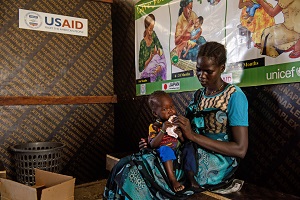Children paying a disproportionate price as famine looms across Somalia, South Sudan, north-east Nigeria and Yemen
This is a summary of a prepared statement by Justin Forsyth, UNICEF Deputy Executive Director – to whom quoted text may be attributed – to the Senate Foreign Relations Subcommittee on Multilateral International Development, Multilateral Institutional Economic, Energy and Environmental Policy on Jul 18.

Nyajak Thuok, 20, feeds her one-year-old son Pal Juneng a sachet of ready-to-use therapeutic food (RUTF) in Bentiu, South Sudan.
The statement came as UNICEF released its annual Humanitarian Action Study, highlighting UNICEF’s global response in 2016. Last year, UNICEF responded to 344 humanitarian situations in 108 countries, more than ever before.
“Children are paying a disproportionate price as famine looms across Somalia, South Sudan, north-east Nigeria and Yemen. Nearly 1.4 million children face imminent risk of death, and more than five million children face malnourishment this year.
“The joint international effort to support national and local authorities and communities respond to this crisis is making a difference. Together we are saving lives. Humanitarian actors including UNICEF, other parts of the United Nations and non-governmental organisations are reaching at least 10 million people each month in the four countries with life-saving assistance.
“But the threat of famine has not passed. Unless we sustain and further scale up our collective efforts, there is the risk that many more millions of children will die of hunger or be permanently stunted. And the longer these crises go on, the greater the risk of new emergencies within these emergencies – like the cholera outbreak in Yemen.
“We must re-double our efforts to deliver at scale, to find ways to address the obstacles that so far are preventing us reaching some of the most vulnerable children and communities, avert new emergencies and help put millions of families on a path to sustainable recovery. And much more needs to be done to address the root causes of these crises, bringing an end to protracted conflicts and human rights violations and linking our emergency humanitarian response to effective development support which addresses the underlying vulnerabilities of communities.
“Conflict, extreme climate events like drought, environmental degradation, climate change, loss of livelihoods and poverty all underpin these looming famines and crises. Unless we address these causes we will continue to get recurrent crises.
“Civilians caught up in conflict need the United Nations Security Council and influential international actors to do more to require parties to these conflicts to meet their obligations under international norms and laws. Better protection for civilians caught up in conflicts and unimpeded access for every person in need, wherever they are, would rapidly reduce human suffering. A renewed diplomatic push is needed to end these protracted conflicts. The diplomatic efforts of the United States are needed more than ever.
“This also means that countries, regions and the international community need to do more to prepare for and build resilience against environmental and climate-related crisis such as recurring drought.
“The stakes for children across these four countries and their sub-regions could not be higher. Nearly 1.4 million children are at imminent risk of death, and many more millions of children are at risk unless we turn these crises around and build sustainable recovery. The longer we wait to address these children’s needs, the more we jeopardize their future. Children and families facing the gravest threats count on the leadership and generosity of the people of the United States to stand with them, to help them survive this crisis and go on to build a brighter future for themselves and their countries.
Source:United Nations Children's Fund
- 294 reads
Human Rights
Fostering a More Humane World: The 28th Eurasian Economic Summi

Conscience, Hope, and Action: Keys to Global Peace and Sustainability

Ringing FOWPAL’s Peace Bell for the World:Nobel Peace Prize Laureates’ Visions and Actions

Protecting the World’s Cultural Diversity for a Sustainable Future

Puppet Show I International Friendship Day 2020

